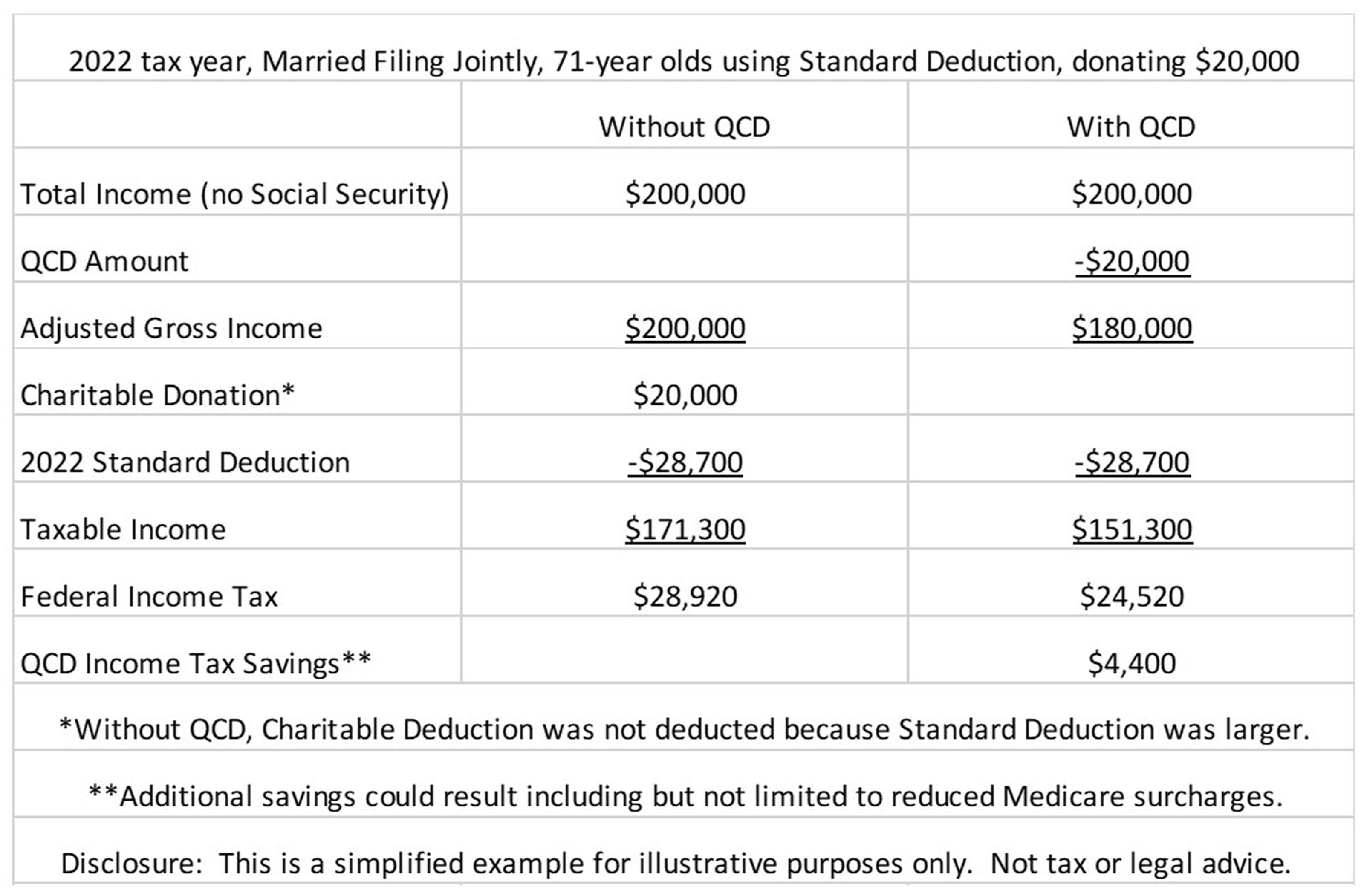Tax-Savvy Charitable Giving With QCDs Can Benefit Both Giver and Receiver
A qualified charitable distribution, or QCD, might be the answer for you – but watch those rules.


Plenty of retirees like to give back to their communities through charitable donations, but questions often arise over the best way to do that.
What approach is efficient, provides the tax benefits you’re after, and also is advantageous for the charity that’s on the receiving end?
One possibility is a qualified charitable distribution (QCD), a tax-savvy way to reduce your taxable income and maximize your donations whether you itemize deductions on your tax return or not. An added bonus is that the benefits can be large for both the donor and the charity.

Sign up for Kiplinger’s Free E-Newsletters
Profit and prosper with the best of expert advice on investing, taxes, retirement, personal finance and more - straight to your e-mail.
Profit and prosper with the best of expert advice - straight to your e-mail.
Here’s how QCDs work
A QCD is a distribution from an IRA that is paid directly from that retirement account to a qualified charity. QCDs lower your adjusted gross income (AGI) and therefore lower your tax bill. They can also offset required minimum distributions (RMDs), those withdrawals you must take from your IRA each year once you reach age 72. An RMD adds to your income, raising the amount of taxes you pay, but a QCD is excluded from your income. So, for example, if you withdrew $50,000 from your IRA as an RMD, you would pay taxes on that money. But if that same $50,000 was used as a QCD instead, you avoid the taxes while helping a charity at the same time.
Taxpayers can benefit from QCDs even when they take the standard deduction and do not itemize their deductions. Meanwhile, even though a QCD doesn’t count as an itemized deduction, taxpayers who itemize still benefit because an exclusion is better than an itemized deduction because it lowers their AGI. AGI is an important number on your tax return because many tax benefits, deductions, credits and other additional taxes or charges are based on AGI. With a lower AGI, income tax on Social Security benefits may be reduced and Medicare surcharges may be lowered. There may be other benefits as well.
Some rules to follow
There are important rules that govern how QCDs work, including:
- The charity you give to must be a 501(c)(3) organization that is eligible to receive tax-deductible contributions. Donor-advised funds, supporting organizations (that is, organizations that give to other public charities), and private foundations are not qualifying charities.
- The donor may not receive any benefit for making the distribution to the charity. As examples, the donor may not receive tickets to a charity event, purchase raffle tickets, or buy something in a charity auction.
- There is an age requirement involved. The donor must be older than 70½ and may make QCDs before RMDs are required, which happens beginning at age 72.
- The maximum annual QCD is $100,000 per person, not per IRA. A husband and wife can each make up to a $100,000 QCD only if the money comes out of their own IRA.
- The QCD must be a direct transfer from the IRA to the charity. Preferably, the IRA administrator would cut the check. It is not permissible for the IRA administrator to pay the IRA owner and for the owner to then write a personal check to the charity.
- QCDs are available from IRAs and inherited IRAs. QCDs also can be made from SEP IRAs and SIMPLE IRAs, but only if those IRAs are inactive, meaning that the SEP or SIMPLE IRA owner is no longer making contributions to these accounts. Additionally, only pre-tax IRA funds qualify. As a result, most Roth IRA funds won’t qualify because your contributions to them were not pre-tax. QCDs also cannot be made from employer plans, such as a 401(k).
- Taxpayers should notify their tax preparer that they made a QCD because the 1099 issued by the custodian does not specify a QCD; it only shows that a distribution was made from the IRA. If the QCD is not referred to on the tax return, the taxpayer loses the tax break.
- A required minimum distribution can be offset by a QCD (up to $100,000). However, the timing of a QCD is important in this case. The first dollars withdrawn from an IRA each year are counted toward the RMD. You cannot retroactively claim that money already distributed from an IRA was actually QCD funds. Said another way, once an RMD is taken, that income cannot be offset with a future QCD. It is therefore generally recommended that QCDs be done early in the year, particularly if IRA distributions are made monthly or quarterly.
What the tax savings could look like
A qualified charitable distribution can be a powerful tax-savvy tool for those who qualify and who make sure they keep to the rules.
As you can see, though, making sure everything is done right can get complicated, so it’s best to find a financial professional who can assist you in working through these rules and getting everything right.
Example of Potential QCD Savings

Ronnie Blair contributed to this article.
The appearances in Kiplinger were obtained through a PR program. The columnist received assistance from a public relations firm in preparing this piece for submission to Kiplinger.com. Kiplinger was not compensated in any way.
Securities and advisory services offered through Sunbelt Securities, Inc. Member FINRA / SIPC. Fixed Life Insurance and Annuities offered through Charles W. Rawl & Associates, LLC. Charles W. Rawl & Associates, LLC and Sunbelt Securities, Inc. are unaffiliated companies and neither provides tax or legal advice.
Related Content
Get Kiplinger Today newsletter — free
Profit and prosper with the best of Kiplinger's advice on investing, taxes, retirement, personal finance and much more. Delivered daily. Enter your email in the box and click Sign Me Up.

As president of Charles W. Rawl & Associates, LLC, Charlie Rawl has distinguished himself as a troubleshooter by implementing creative solutions to complex financial problems. He has passed the Series 6, 7, 31, 63 and 65 securities exams and holds life insurance licenses in more than a dozen states.
-
 6 Stunning Waterfront Homes for Sale Around the US
6 Stunning Waterfront Homes for Sale Around the USFrom private peninsulas to lakes, bayous and beyond, Kiplinger's "Listed" series brings you another selection of dream homes for sale on the waterfront.
By Charlotte Gorbold Published
-
 Six Reasons to Disinherit Someone and How to Do It
Six Reasons to Disinherit Someone and How to Do ItWhether you're navigating a second marriage, dealing with an estranged relative or leaving your assets to charity, there are reasons to disinherit someone. Here's how.
By Donna LeValley Published
-
 Should You Still Wait Until 70 to Claim Social Security?
Should You Still Wait Until 70 to Claim Social Security?Delaying Social Security until age 70 will increase your benefits. But with shortages ahead, and talk of cuts, is there a case for claiming sooner?
By Evan T. Beach, CFP®, AWMA® Published
-
 Retirement Planning for Couples: How to Plan to Be So Happy Together
Retirement Planning for Couples: How to Plan to Be So Happy TogetherPlanning for retirement as a couple is a team sport that takes open communication, thoughtful planning and a solid financial strategy.
By Andrew Rosen, CFP®, CEP Published
-
 Market Turmoil: What History Tells Us About Current Volatility
Market Turmoil: What History Tells Us About Current VolatilityThis up-and-down uncertainty is nerve-racking, but a look back at previous downturns shows that the markets are resilient. Here's how to ride out the turmoil.
By Michael Aloi, CFP® Published
-
 Home Insurance: How to Cut Costs Without Losing Coverage
Home Insurance: How to Cut Costs Without Losing CoverageNatural disasters are causing home insurance premiums to soar, but don't risk dropping your coverage completely when there are ways to keep costs down.
By Jared Elson, Investment Adviser Published
-
 Markets Roller Coaster: Resist the Urge to Make Big Changes
Markets Roller Coaster: Resist the Urge to Make Big ChangesYou could do more harm than good if you react emotionally to volatility. Instead, consider tax-loss harvesting, Roth conversions and how to plan for next time.
By Frank J. Legan Published
-
 Why Homeowners Insurance Has Gotten So Very Expensive
Why Homeowners Insurance Has Gotten So Very ExpensiveThe home insurance industry is seeing more frequent and bigger claims because of weather, wildfires and other natural disasters.
By Karl Susman, CPCU, LUTCF, CIC, CSFP, CFS, CPIA, AAI-M, PLCS Published
-
 Going Through Probate? How to Find the Right Attorney
Going Through Probate? How to Find the Right AttorneyJust having the skills and experience to do the job isn't enough. The probate attorney you hire needs to have the right temperament for your particular case.
By John R. Silva, Esq. Published
-
 Widow's Penalty: Three Ways to Protect Your Finances
Widow's Penalty: Three Ways to Protect Your FinancesHigher Medicare premiums, smaller Social Security payments, bigger tax bills … Financial changes can hit hard when a spouse dies. How to counter the blow.
By Ashley Terrell, IAR Published